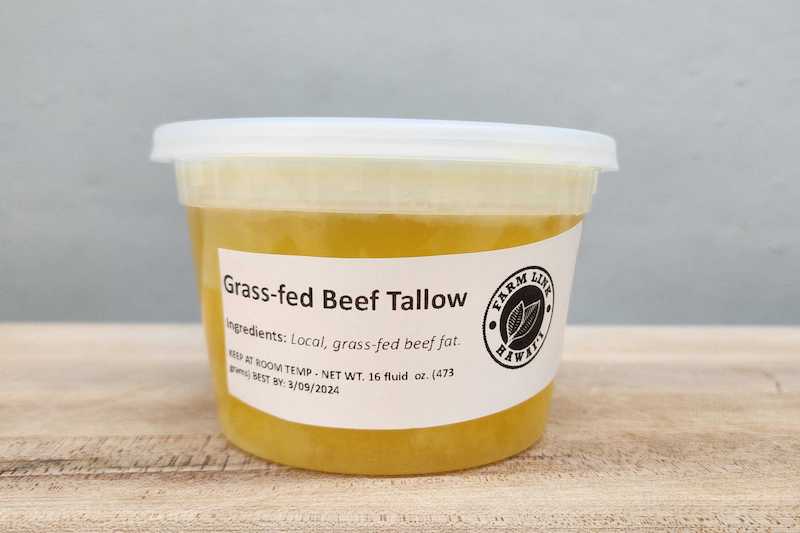Introduction: What is Grass-Fed Beef Tallow?
Grass-fed beef tallow is a nutrient-dense fat derived from cattle that are raised on grass. It’s been gaining popularity as a healthier alternative to vegetable oils and traditional cooking fats like butter. But you might be wondering: is grass-fed beef tallow healthy? In this article, we will explore its nutritional profile, the health benefits, and whether it’s the right fat choice for you.

What Makes Grass-Fed Beef Tallow Unique?
It is different from regular tallow due to the way the cattle are raised. Cattle that are grass-fed have higher levels of essential nutrients like omega-3 fatty acids, which are often lacking in grain-fed beef. The fats found in grass-fed beef tallow are rich in beneficial compounds like CLA (conjugated linoleic acid), which has been shown to have positive effects on health.

Health Benefits of Grass-Fed Beef Tallow
1. Rich in Omega-3 Fatty Acids
One of the key reasons people choose it over other cooking fats is its omega-3 content. Omega-3s are essential fatty acids that have been linked to numerous health benefits, including reducing inflammation, supporting heart health, and improving cognitive function. Grass-fed beef tallow contains more omega-3 fatty acids than tallow derived from grain-fed cattle, making it a healthier choice.
2. Contains Conjugated Linoleic Acid (CLA)
It is also a good source of CLA, a fatty acid known for its potential health benefits. Studies suggest that CLA may help with weight management, improve metabolic health, and promote fat loss. Incorporating grass-fed beef tallow into your diet could be a simple way to boost your intake of this beneficial compound.
3. Healthy Saturated Fats
While saturated fats have been scrutinized in the past, not all saturated fats are created equal. The saturated fats in grass-fed beef tallow are more stable and less prone to oxidation compared to unsaturated fats, which makes it a safer choice for high-heat cooking. These fats can also provide sustained energy throughout the day, especially for those on low-carb or ketogenic diets.
How to Use Grass-Fed Beef Tallow in Cooking
It has a high smoke point, making it ideal for high-temperature cooking methods like frying, roasting, or sautéing. It can also be used in baking as a substitute for butter or vegetable oils. Here are some creative ways to use it:
- Frying: Great for frying vegetables, meats, and even potatoes.
- Baking: Use it in place of butter in your baking recipes for a rich flavor.
- Cooking Meat: Enhance the flavor of your meats by using tallow in your cooking process.

Grass-Fed Beef Tallow vs. Other Fats
When comparing it to other fats, it’s clear that it offers a number of advantages:
- Tallow vs. Butter: While both tallow and butter are rich in saturated fats, grass-fed beef tallow has a higher concentration of omega-3s and CLA, which are beneficial for overall health.
- Tallow vs. Vegetable Oils: Vegetable oils, especially those high in omega-6 fatty acids, can contribute to inflammation in the body when consumed in excess. Grass-fed beef tallow, on the other hand, has a much better omega-3 to omega-6 ratio.
Is Grass-Fed Beef Tallow the Right Choice for You?
So, is grass-fed beef tallow healthy? The answer is yes—when consumed in moderation, it provides numerous health benefits, including improved heart health, weight management, and better metabolic function. It is a great option for those looking for a healthy cooking fat, especially for high-heat cooking or when following a low-carb diet.
However, it’s important to balance your fat intake. While grass-fed beef tallow is healthy, it’s still a calorie-dense food, so moderation is key. Incorporating a variety of healthy fats in your diet is the best approach to achieving optimal health.
Additional Resources:
- How to Incorporate Healthy Fats Into Your Diet (This would be an internal link to another relevant post on your website)
- The Benefits of Omega-3 Fatty Acids for Heart Health (Internal link to related post)
- Harvard Health – Healthy Fats and Oils (DoFollow)
- Sleep Foundation – Omega-3 Fatty Acids (DoFollow)


